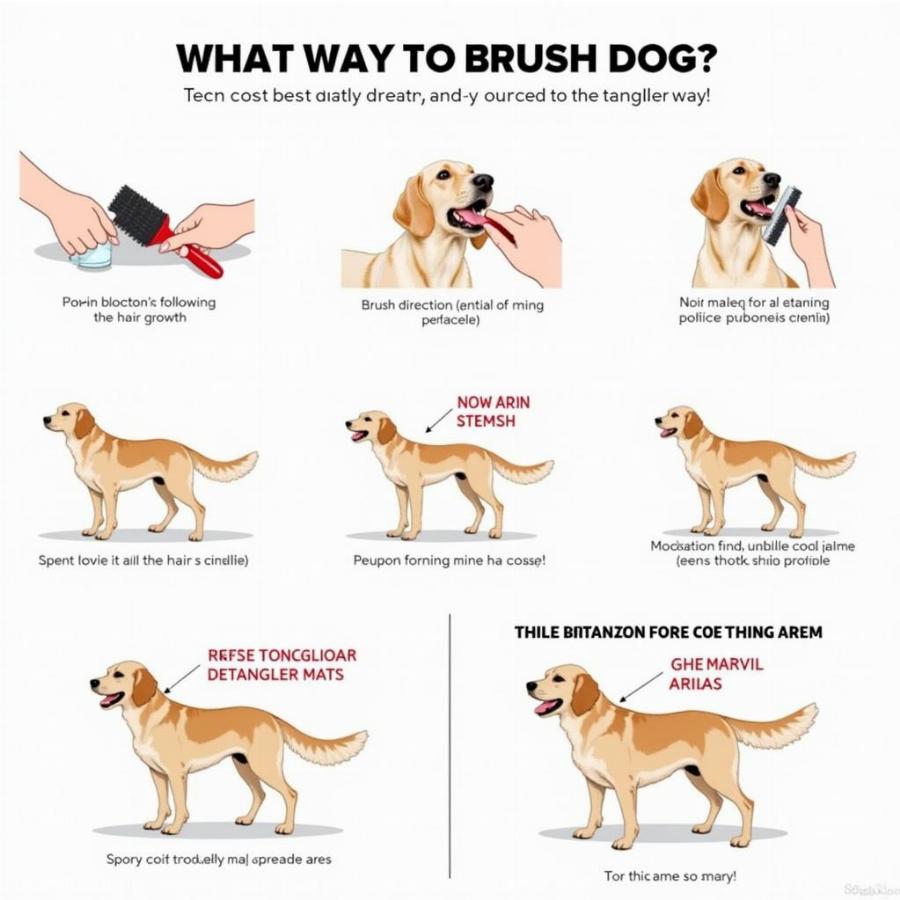Choosing the right brushes for dogs can be a daunting task with so many options available. This guide will help you understand the importance of brushing, the different types of brushes available, and how to choose the perfect one for your furry friend’s coat type and grooming needs. We’ll also cover proper brushing techniques and other essential grooming tips to keep your dog looking and feeling their best.
Understanding the Importance of Brushing Your Dog
Regular brushing is crucial for maintaining a healthy and beautiful coat. It helps remove loose hair, dirt, and debris, preventing matting and tangles. Brushing also stimulates blood circulation to the skin, distributing natural oils that keep the coat shiny and healthy. Furthermore, it’s a great way to bond with your dog and check for any skin irritations or parasites.
Types of Brushes for Dogs
There are various types of brushes for dogs, each designed for specific coat types and grooming purposes. Here’s a breakdown of the most common ones:
- Bristle Brushes: Ideal for short-haired breeds, bristle brushes help remove loose hair and distribute natural oils.
- Slicker Brushes: Perfect for removing mats and tangles in medium to long-haired dogs, thanks to their fine wire bristles.
- Pin Brushes: Similar to slicker brushes, but with less dense pins, these are gentler on the skin and suitable for dogs with sensitive skin or fine coats.
- Rake Brushes: Designed to penetrate thick double coats and remove loose undercoat, preventing shedding.
- Mat Breakers: Specifically made to cut through tough mats and tangles, these should be used with caution to avoid hurting your dog.
- Grooming Gloves: A convenient option for short-haired breeds, grooming gloves allow you to massage your dog while removing loose hair.
Choosing the Right Brush for Your Dog’s Coat
Choosing the right brush depends on your dog’s coat type. wet brush for dogs are particularly helpful for dogs with long, easily tangled fur. Here’s a quick guide:
- Short & Smooth Coats: Bristle brushes or grooming gloves.
- Medium Coats: Slicker brushes or pin brushes.
- Long Coats: Slicker brushes, pin brushes, or rake brushes.
- Double Coats: Rake brushes and undercoat rakes.
- Curly Coats: Slicker brushes or pin brushes.
- Wiry Coats: Slicker brushes or curry brush for dogs.
How to Brush Your Dog Properly
 Proper Dog Brushing Techniques
Proper Dog Brushing Techniques
Brushing your dog should be a pleasant experience for both of you. Always be gentle and use the correct technique:
- Start with a clean, dry coat.
- Brush in the direction of hair growth.
- Use short, gentle strokes.
- Be extra careful around sensitive areas like the face, ears, and belly.
- If you encounter a mat, use a detangling spray and gently work it out with a mat breaker or slicker brush. Never pull or yank the mat, as this can hurt your dog.
Other Essential Grooming Tips
Beyond brushing, regular grooming includes nail trimming, ear cleaning, and dental care. A toothbrush for dogs is essential for maintaining their oral hygiene. Regular grooming brushes for dogs will also contribute to their overall health and well-being.
Conclusion
Choosing the right brushes for dogs and implementing proper brushing techniques are vital for maintaining their coat health and overall well-being. By understanding your dog’s specific coat type and using the appropriate tools, you can ensure a comfortable and effective grooming experience, strengthening your bond while keeping your furry friend looking their best.
FAQ
- How often should I brush my dog? The frequency depends on your dog’s coat type. Short-haired breeds may only need weekly brushing, while long-haired breeds may require daily brushing.
- Can I use human brushes on my dog? No, human brushes are not designed for dog coats and can cause damage.
- What should I do if my dog hates being brushed? Start slowly and use positive reinforcement, such as treats and praise. Make it a positive experience for your dog.
- How do I clean my dog’s brushes? Remove loose hair after each use and wash the brushes regularly with warm soapy water.
- What are the signs of a skin problem? Look for redness, itching, excessive scratching, hair loss, or any unusual bumps or sores.
Do you have other questions about dog care? You might be interested in these articles:
Beaut Dogs is your one-stop shop for all things dog-related. We offer expert advice, helpful tips, and in-depth information on the wonderful world of dogs. From breed specifics to grooming guides and everything in between, Beaut Dogs is here to help you provide the best possible care for your furry companion. When you need help, please contact Email: [email protected] to get detailed and accurate answers from Beaut Dogs.